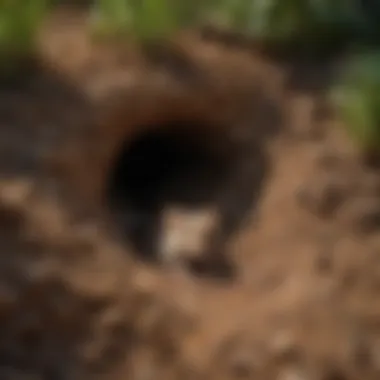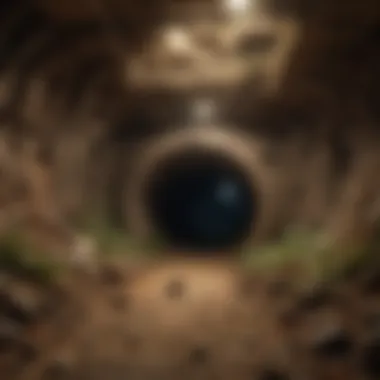Exploring the Habitats of Mice: Underground Life Insights


Intro
Mice are often seen as mere pests, yet their behavior and living habits are complex and interesting. Understanding these small creatures helps us manage their presence better. One question often arises: Do they live underground? This article investigates the various habitats of mice, particularly focusing on those species that prefer to dwell beneath the surface.
Identification of Common Pests
Description of Common Pests
Mice belong to the family Muridae, with common species including the house mouse (Mus musculus), field mouse (Apodemus spp.), and deer mouse (Peromyscus maniculatus). Each of these species exhibits unique behaviors and preferences for habitat. The house mouse is well adapted to urban life, often taking residence in homes, while field mice tend to occupy open fields and woodlands.
Signs of Infestation
Identifying a mouse infestation early can save homeowners significant trouble. Common signs include:
- Droppings: Small, dark pellets typically found along pathways or near nesting sites.
- Gnaw marks: Visible damage to food packages, furniture, or wiring can indicate rodent activity.
- Nests: Mice build nests using soft materials like paper, fabric, or insulation, often hidden in secluded areas.
- Nocturnal sounds: Scratching noises at night may signal mice moving about in search of food or nesting.
Prevention Techniques
Home Maintenance Tips
Maintaining a mouse-free home requires diligent precautions. Here are some effective strategies:
- Seal entry points: Check for gaps or holes in walls, floors, and around pipes. Use steel wool or caulk to close these openings.
- Store food properly: Keep food in airtight containers. Mice are attracted to easily accessible food sources.
- Maintain cleanliness: Regularly clean all areas, ensuring crumbs or spills are promptly addressed. The less accessible food there is, the less inviting the environment.
Environmental Modifications
Beyond sealing entry points and cleanliness, landscaping can also deter mice. Consider:
- Removing clutter: Keep gardens and yards free of debris where mice might hide.
- Lawn care: Maintain short grass and avoid dense vegetation that creates hiding spots.
Eco-Friendly Pest Control Options
Natural Pesticides
For those seeking alternatives to harsh chemicals, natural pesticides can be effective. Essential oils like peppermint or eucalyptus are known for repelling mice. Spraying diluted mixtures around entry points can serve as a deterrent.
Organic Pest Control Techniques
In addition to natural repellents, many organic pest control methods can help manage mouse populations:
- Traps: Use humane traps to catch mice without causing harm.
- Natural predators: Encouraging barn owls or maintaining cats can have a significant impact on reducing mouse populations organically.
Understanding the habitats of mice and how to control their presence is crucial. Implementing preventive measures and using eco-friendly methods not only protects your home but also supports a balanced environment.
By exploring the habits and habitats of mice, we gain valuable insight into their behavior. We can manage these common pests effectively and sustainably. For more information on mouse habits, consider visiting Wikipedia or Britannica.
Understanding Mice: An Overview
Mice are fascinating creatures that have adapted to various environments, making them a subject of interest in both ecological and pest control discussions. This overview serves to lay the groundwork for a detailed exploration of their habitats, focusing on their tendency to live underground. Understanding the biology and behavior of mice can help homeowners manage invasions and also appreciate their role in the ecosystem.
Knowing more about the living habits of mice can lead to better management strategies. Mice are often seen as pests, yet they play vital roles in their ecosystems. They contribute to soil aeration through burrowing and serve as prey for numerous predators. Without understanding these aspects, it is challenging to create effective pest control measures.
Key elements discussed in this section include:
- The biological classification of mice, which helps categorize them within the animal kingdom.
- Key characteristics that distinguish various species and influence their habitat choices.
These elements not only inform about mice's ecological niches but also highlight the importance of addressing their presence in urban settings.
Biological Classification
Mice belong to the family Muridae, which encompasses a wide range of species, including rats and voles. Within this family, the genus Mus includes the house mouse (Mus musculus) and the deer mouse (Peromyscus maniculatus). Each species exhibits its own set of traits and preferences that influence where they choose to live.


Taxonomically, mice can be broadly classified into two main categories:
- Wild Mice: These include various species that live in natural habitats. Their living conditions are primarily dictated by available resources, predation risk, and environmental factors.
- Domestic Mice: These are often found in human buildings, seeking food and shelter from predators. They have adapted well to urbanization.
Key Characteristics
Mice share several common characteristics that facilitate their survival in diverse habitats. These include:
- Small Size and Agility: Mice typically have small, slender bodies which enable them to fit into small crevices or burrow effectively underground.
- Reproductive Potential: Mice have high reproductive rates, allowing them to establish populations quickly in suitable habitats.
- Dietary Flexibility: Mice are omnivores and can thrive on a wide variety of foods. This adaptability allows them to inhabit areas rich in resources, whether urban or rural.
Understanding these characteristics is crucial for homeowners. Knowledge about mice behaviors can guide effective prevention and control measures, enhancing efforts to safeguard homes from potential infestations.
By recognizing the natural behaviors and characteristics of mice, one can effectively engage in pest management and ecological discussions.
Natural Habitat Preferences
Understanding the natural habitat preferences of mice is essential in comprehending their behavior and adaptability. Mice, being highly diverse in species, show a range of habitat preferences that often reflect their survival strategies. By exploring these preferences, we can gain insights into how environmental conditions shape their behaviors and living arrangements, particularly underground.
Types of Habitats
Mice inhabit various environments, which can be categorized into several types:
- Grasslands: Here, mice can find abundant food sources like seeds and plants. The open terrain allows for easy movement and burrow construction.
- Forests: These areas provide shelter from predators and extreme weather. Mice often nest in fallen leaves or alongside tree roots.
- Urban Areas: Adaptation to human environments is significant. Mice often utilize basements, attics, and spaces under concrete structures.
- Agricultural Lands: Fields provide both food and nesting sites, making them popular habitation areas for various mouse species.
The choice of habitat influences not only their survival but also their interaction with humans and other wildlife. For example, field mice may thrive in agricultural lands while house mice are more commonly found in urban settings.
Environmental Factors Influencing Habitat
Several environmental factors play a role in the habitat preferences of mice:
- Availability of Food: Proximity to food sources dictates where mice establish their nests. Areas rich in vegetation or human food scraps attract more mice.
- Predator Presence: The threat from predators can deter mice from certain areas. Habitats that provide shelter are more appealing as they offer protection.
- Climate Conditions: Mice may migrate to more suitable climates that ensure their survival. For instance, extreme cold may push them into warmer, underground shelters.
Understanding these factors informs pest control strategies and helps homeowners anticipate potential infestations.
In summary, the study of natural habitat preferences among mice is essential for various stakeholders, including homeowners, pest control experts, and ecologists. Recognizing where and how these creatures thrive can help manage their populations effectively.
Subterranean Living: A Closer Look
Subterranean living is a fascinating aspect of mouse behavior that deserves particular attention in our exploration of their habitats. Mice, as small mammals, have developed a range of adaptations to thrive in underground environments. This section will elaborate on specific behaviors and advantages of living beneath the surface. Understanding these factors illuminates why such habitats are essential for the survival of these creatures and how this affects their interactions with humans and the environment.
Burrowing Behaviors
Mice exhibit various burrowing behaviors that allow them to create homes suitable for nesting and foraging. These behaviors can vary greatly depending on species and environmental conditions. For example, the house mouse is known for digging small tunnels near human dwellings, while field mice may create elaborate networks in open fields.
- Construction of Burrows: Mice will often dig intricate burrows, sometimes up to several feet deep. They use their sharp claws for digging and their agile bodies to maneuver through tight spaces.
- Nest Building: Inside their burrows, mice create nests using available materials such as grass, leaves, and shredded paper. This offers insulation and protection for their young.
- Foraging Paths: Mice will establish foraging pathways over time, which helps them navigate between food sources and their burrows efficiently.
These behaviors are not merely instinctual; they also play a critical role in their survival. A well-structured burrow provides shelter from predators and environmental extremes, enhancing the mouse’s chances of thriving.
Advantages of Underground Living
Living underground presents several distinct advantages for mice compared to above-ground habitats. These benefits are significant factors in their habitat preferences.
- Protection from Predators: Being underground offers a safer environment for mice, reducing exposure to common predators such as hawks, cats, and snakes.
- Thermal Stability: Soil provides a more stable temperature compared to surface temperatures, which can fluctuate widely. This stability is crucial for temperature regulation and comfort, particularly in extreme climates.
- Access to Food Sources: Many food sources for mice, such as roots and seeds, are found underground. This easy access supports their foraging needs without risking exposure to larger threats.
- Reduced Competition: Underground habitats can also offer reduced competition for resources. While many mammals prefer surface living, mice can exploit niches that other species might overlook.
"Mice's unique adaptation to underground living not only secures their survival but illustrates their remarkable resilience in diverse environments."
Overall, understanding subterranean living provides valuable insights into mouse behavior and ecology. It helps illuminate the relevance of these habitats, especially in the context of pest control and conservation efforts. As urban areas expand, the dynamics between human environments and the subterranean lives of mice will continue to evolve. Knowing these factors is crucial for homeowners and pest control professionals aiming to manage mouse populations effectively.
Species of Mice Commonly Found Underground
Understanding the species of mice that commonly inhabit underground spaces plays a vital role in developing effective pest control strategies. By identifying specific species, one can recognize their behaviors, nesting habits, and potential impact on both natural and human environments. This knowledge aids homeowners in implementing preventative measures, while also fostering respect for the ecological role mice play.


House Mouse
The house mouse, scientifically known as Mus musculus, is among the most prevalent species in urban areas. They often make their nests in hidden, secluded places, frequently below ground near human habitations. Their small size and adaptability allow them to enter homes through tiny openings. This species typically prefers areas near food and moisture, making basements and crawl spaces prime locations for nesting.
House mice are known for their rapid reproduction rates. A single pair can produce dozens of offspring each year if conditions are favorable, which makes them a formidable pest if left uncontrolled. The ability to flourish in urban settings illustrates their adaptability and resourcefulness. Homeowners should be vigilant. Regular inspections for signs of house mice are critical to prevent infestations.
Field Mouse
Field mice, or Apodemus sylvaticus, typically reside in agricultural and rural environments but also have underground habits. They prefer fields, meadows, and woods, digging extensive burrow systems. These burrows provide shelter from predators and harsh weather, with multiple chambers for nesting and food storage. While field mice are generally more inclined to live above ground compared to house mice, their burrowing behaviors certainly classify them as a species that utilizes underground habitats effectively.
Their diet primarily consists of seeds, fruits, and plants, which they gather and store within their burrows. During specific seasons, the field mouse may enter urban areas for food. When adapting to these environments, they may seek shelter within gardens, yards, or even basements, causing concern for homeowners. Understanding their behavior can help individuals mitigate potential issues.
Deer Mouse
The deer mouse, known scientifically as Peromyscus maniculatus, is well adapted to a variety of habitats, including forests and grasslands. This species is particularly fascinating due to its wide range of environments, including underground spaces. Their burrowing instinct leads them to create extensive tunnels in loose soil. They are primarily nocturnal and remain concealed during the day, which helps them avoid predators.
Deer mice are known to carry hantavirus, which makes them significant from a health perspective. Their nesting in underground areas can pose risks, especially if they come into contact with human living spaces. Their dietary flexibility adds to their resilience; they consume seeds, insects, and even fungi.
Behaviors of Mice in Underground Environments
Understanding the behaviors of mice in underground environments is crucial for several reasons. It informs pest control strategies and highlights the biological adaptability of these creatures. Knowledge of their behaviors helps homeowners identify potential issues with infestations. Moreover, recognizing how these mice interact with their surroundings can lead to better management techniques for both prevention and eradication.
Nest Building and Reproduction
Mice exhibit specific strategies when it comes to nest building, especially in underground habitats. They often choose secluded, hidden areas to construct their nests. The materials they select are varied, including shredded paper, fabric, and nesting grass.
Underground nesting offers benefits like protection from predators and harsh environmental conditions. Mice will frequently have several nests within close proximity to their foraging grounds, allowing for easy access to food while maintaining security. Moreover, when conditions are favorable, mice reproduce quickly, resulting in a surge in their populations. This can lead to more severe infestations in human dwellings if not addressed promptly.
Foraging and Feeding Habits
Foraging behaviors of mice in underground environments are also interesting. They tend to forage within a radius that is safe from threats, usually venturing out for short periods. Mice are opportunistic feeders, consuming a wide range of foods including grains, seeds, and even insects if available.
Their feeding habits are usually dictated by seasonal changes. For instance, fruit and seeds are more accessible in warmer months, while they may rely on stored food during colder months. The need for survival drives these feeding patterns, making it essential for homeowners to understand these habits.
Recognizing these foraging habits can play a significant role in pest control strategies. By ensuring that potential food sources are removed from accessible areas, homeowners can minimize the likelihood of attracting mice to their properties.
"Recognizing the role of nesting and foraging behaviors allows for better management of mouse populations and prevents infestations."
Impact of Urbanization on Mice Habitats
Urbanization has significantly changed the habitats in which mice thrive. As cities expand, the natural environments of these rodents become altered, influencing their behavior and living patterns. This topic is important as it sheds light on the consequences of human development on wildlife, particularly on common species like mice. Understanding how mice adapt to urban settings can provide valuable insights for homeowners and pest control professionals.
Adaptation to Human Environments
Mice, particularly species like the House Mouse, exhibit remarkable adaptability to human environments. Their ability to thrive in urban areas is due in part to the abundant food sources available. Trash, food waste, and even pet food can provide a steady diet. Mice can navigate the complexities of urban landscapes, including streets, buildings, and gardens, to locate resources.
Moreover, urban settings offer numerous shelter options. Mice can find refuge in basements, attics, and even wall cavities. This adaptability allows them to coexist alongside humans, often without notice. Additionally, they tend to have reduced natural predators in cities, making urban living more appealing.
Changes in Living Patterns
The living patterns of mice in urban environments differ from those in natural habitats. In the wild, mice typically construct elaborate burrow systems for nesting and protection. In contrast, urban mice often rely on temporary shelters, taking advantage of man-made structures.
- Social Structure: Urban mice may form larger colonies due to high population density. More individuals in close proximity can lead to changes in behavior, such as altered foraging habits and increased competition for resources.
- Breeding Cycles: The breeding cycles of urban mice can also shift. With stable food availability throughout the year, they may reproduce more frequently compared to their rural counterparts.
- Mobility: Urban mice are often more mobile. Their living arrangements allow them to explore larger areas in search of food, leading to a more opportunistic feeding strategy.
As urban areas continue to grow, understanding these changes is vital. Knowledge about the adaptive behaviors of mice can help inform effective pest management practices.
"Since urbanization modifies natural habitats, it can have profound effects on the behavior and population dynamics of rodents like mice."
To summarize, the impact of urbanization on mice habitats is a significant factor in their survival and adaptation. Considering these changes allows us as homeowners to develop more effective strategies for pest management.
Pest Control Implications


Understanding the pest control implications related to the underground habitats of mice is crucial for homeowners. Such knowledge helps identify effective methods for managing infestations, ultimately ensuring a harmonious living environment. The subterranean habits of mice present unique challenges that must be addressed proactively.
Exploring these challenges can unveil the hidden dynamics of urban ecosystems and informs pest control practitioners about where efforts should be focused. Mice thrive in environments that provide food, shelter, and safety. Therefore, integrating habitat management is essential for any pest control strategy.
Challenges of Underground Infestations
Underground infestations pose specific difficulties. Mice enjoy burrowing and nesting in areas that are hard to access, making detection a challenge.
- Hidden Spaces: Their nests can be located beneath floors, in walls, or under structures, often eluding typical inspection methods.
- Reproductive Rates: Mice reproduce quickly, which compounds problems. A small infestation can escalate rapidly if left untreated.
- Damage Potential: The digging habits of mice can cause structural damage to properties, leading to costly repairs. This is especially true when they burrow into foundations or insulation.
These challenges necessitate a thorough understanding of their behavior and habitat preferences.
Effective Control Strategies
To combat underground infestations effectively, a multifaceted approach is recommended.
- Inspection: Regular inspections are vital. Look for signs like droppings, gnaw marks, or nests in hidden areas around your home.
- Exclusion Techniques: Seal entry points and potential access areas. Use materials like steel wool or caulking to block gaps.
- Consistent Monitoring: After initial treatment, continue monitoring to ensure that infestations do not reoccur. Bait stations can help keep track of mouse activity.
- Professional Help: Sometimes, engaging pest control professionals is necessary. They have the expertise and resources to tackle deeply embedded infestations effectively.
“Prevention is always better than cure; keeping an environment less hospitable will deter mice.”
Employing these strategies can minimize risks posed by underground living mice and protect homeowners from potential health hazards and property damage. The key to success lies in understanding their behaviors and habitats, allowing for a proactive rather than reactive approach.
Conservation and Environmental Considerations
Conservation and environmental considerations play a crucial role in understanding the habitats of mice, especially those that make their homes underground. An analysis of mice habitats begins with recognizing their contributions to the larger ecosystem. Mice are not merely pests; they significantly influence various ecological processes, including seed dispersal and soil aeration. Additionally, they act as prey for numerous predators, thus forming a vital component of food webs. This dual role underscores the importance of conserving their habitats as a means of maintaining ecological balance.
Role of Mice in Ecosystems
Mice contribute to their ecosystems in multiple ways. They are known as seed eaters, and their foraging behaviors aid in the dispersal of plant seeds. This process promotes plant growth and biodiversity. Mice also help in soil aeration through their burrowing activities, which fosters healthy soil.
By seeking protective underground environments, they help maintain microhabitats crucial for various organisms.
It's noteworthy that mice are part of the food chain. They serve as prey to birds of prey, snakes, and other carnivorous animals. Thus, their presence indirectly supports the survival of those higher up the chain.
In urban settings, their role is slightly altered. Here, their living patterns often coincide with human spaces, affecting not just the human environment but the broader ecological picture as well. As such, recognizing these roles is essential for determining effective conservation strategies.
Sustainable Pest Management Practices
Given the ecological significance of mice, pest management practices should ideally be guided by sustainability principles. Traditional methods focused solely on eradication can disrupt local ecosystems. Instead, sustainable pest management practices emphasize coexistence and ecological balance.
Some important sustainable practices include:
- Habitat modification: Altering the environment to make it less appealing to mice, such as sealing entry points and reducing food sources.
- Biological controls: Utilizing predators of mice, like owls or cats, to help manage populations naturally.
- Traps with humane aspects: Using live traps that allow for relocation instead of lethal options.
- Community education: Informing homeowners about the behaviors and ecological roles of mice can foster a more positive perception and inform management.
In summary, integrating conservation into pest management leads to practices that are not only effective but also considerate of the ecological dynamics involved. Engaging with the role of mice in ecosystems should always be at the forefront of discussions surrounding pest control, promoting strategies that reflect a greater understanding of the interconnected nature of wildlife and urban living.
"Sustainable practices are key to maintaining not just our homes, but the habitats they inhabit."
Through this balanced approach, homeowners can manage the nuisances caused by mice while contributing to the health of the environment.
Finale
In the context of understanding mouse habitats, the conclusion serves as a critical reflection on the insights gained throughout the article. It encapsulates the significance of recognizing the diverse living situations of different mouse species, particularly their inclination towards underground environments. Such insights are not merely academic; they bear direct implications for homeowners and pest control professionals.
Summary of Key Points
This article presents numerous essential aspects regarding the habitats of mice:
- Mice exhibit a strong preference for specific habitats, influenced by biological and environmental factors.
- Certain species, like the House Mouse, Field Mouse, and Deer Mouse, showcase distinct behaviors and adaptations for subterranean living.
- Underground environments provide advantages such as protection from predators and favorable temperature regulation.
- Urbanization has altered living patterns, forcing mice to adapt to human environments while also complicating pest control measures.
- Understanding the behaviors of mice in these habitats is crucial in developing effective pest management strategies.
Future Directions in Research
There remains a significant opportunity for future research in the field of rodent behavior and habitat preference. Areas of focus could include:
- Longitudinal studies tracking changes in mouse populations in urban settings.
- Research into the ecological impact of mice on underground ecosystems, highlighting their role in nutrient cycling and soil aeration.
- Examination of innovative pest control methods that promote both efficiency and sustainability, minimizing harm to non-target species and the environment.
- Investigating potential genetic adaptations of mice that enable successful colonization of new habitats, especially in urban settings.
As researchers continue to deepen their understanding of these small yet impactful creatures, homeowners and pest control professionals will benefit from updated knowledge that supports smarter, more eco-friendly practices.







